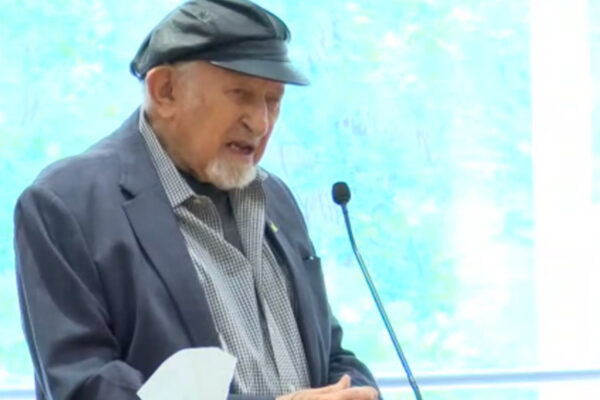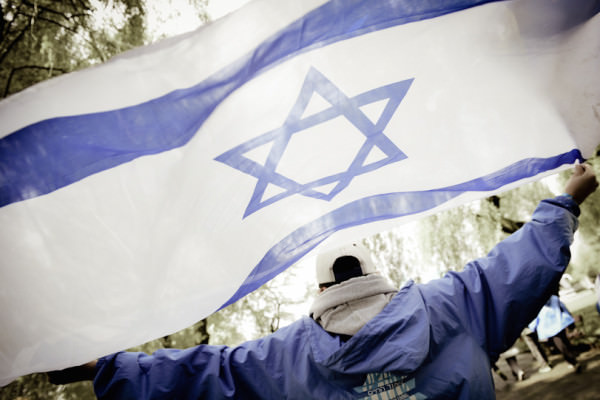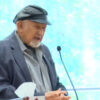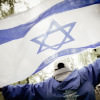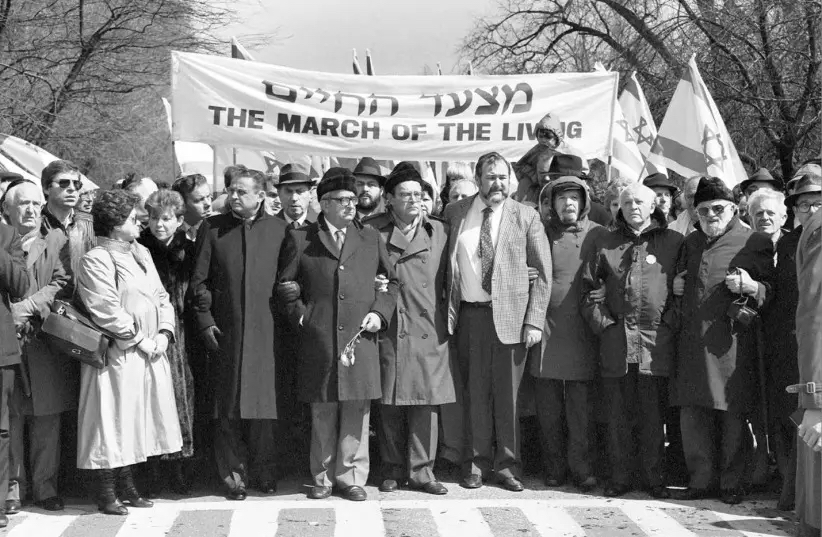
The first March of the Living in 1988 (photo credit: MOSHE MILNER)
Today, the International March of the Living is a well-known and established event on the world calendar of Jewish events. Each year, on Yom HaShoah, thousands flock to the site of the Auschwitz-Birkenau concentration camp to walk the three-kilometer path from Auschwitz I to Auschwitz II-Birkenau. Since its inception thirty-five years ago in 1988, some 300,000 participants from 52 countries around the globe have marched down that path on Holocaust Remembrance Day as a tribute to both the victims and the survivors of the Holocaust.
How did the March of the Living start, what is its meaning, and what is its mission? The Jerusalem Report spoke with Dr. Shmuel Rosenman, International March of the Living Chair and CEO, and Phyllis Greenberg Heideman, President of the International March of the Living, to get a perspective on the origins of the March, its goals, and its importance for the world in 2023.
The first March of the Living was held in 1988, and approximately 1,500 people participated, with half of the participants coming from Israel and the other half from North America and Europe. “We understood,” says Rosenman, who at that time was the superintendent of schools in Tel Aviv, “that you cannot obtain knowledge about the Holocaust and truly understand by studying it in a classroom like regular history.” The organizers, he explains, decided that in order to truly understand the events of the Holocaust, that they would need to visit the sites themselves – places like Auschwitz and Majdanek and Treblinka.
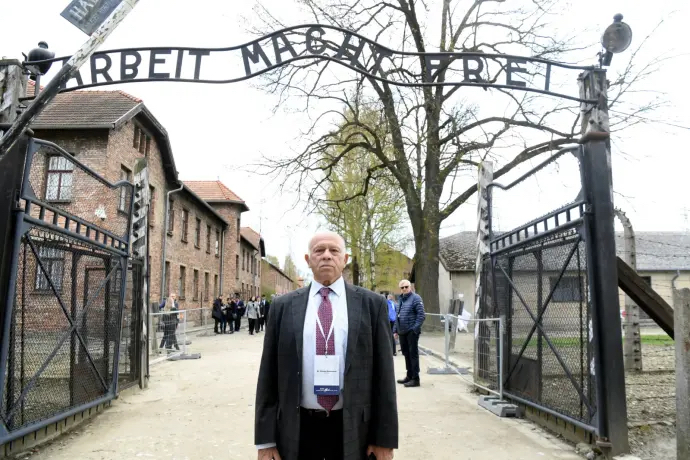
(Credit: Yossi Zeliger)
Rosenman notes that the release of “Shoah,” a French documentary film about the Holocaust, directed by Claude Lanzmann that was released in 1985, lent momentum to the concept of visiting Poland and learning more about the Holocaust. The film, over nine hours long, presented Lanzmann’s interviews with survivors, witnesses and perpetrators and became required viewing in some Israeli high schools.
Recalling that first March of the Living, Rosenman says that in 1988, most Holocaust survivors were in their fifties and sixties and could provide ample material and accounts of what had occurred, making a strong impact on those who attended. “Many of the buses had a number of survivors telling stories,” he says.
Poland under Communist rule
In 1988, Poland was still under Communist rule, and there was insufficient infrastructure to manage the event. Rosenman recalls that the Polish army was called on to help and provided hot water for tea and coffee. Kosher food had to be brought in from Israel.
At that time, Rosenman believed that the March would be a one-time event that would not be repeated. It was only after the participants returned to their home communities that people realized that the initiative was a major breakthrough that needed to continue.
Though the Israeli-born Rosenman does not come from a family that experienced the horrors of the Holocaust, he was a high school student during the trial of Nazi Adolf Eichmann in Israel in 1961 and 1962. He recalls the dramatic trial that was broadcast throughout the world and says that it made a significant impact on him.
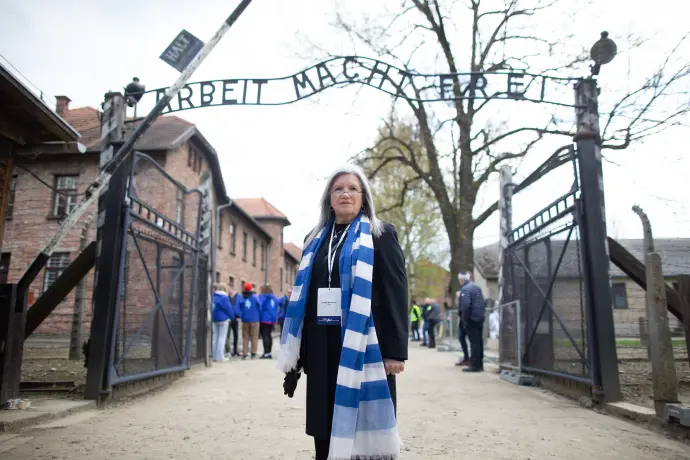
(Credit: Sam Churchill)
Phyllis Greenberg Heideman, President of the March of the Living, became involved in the March through her work as a member of the United States Holocaust Memorial Council, to which she had been appointed by President George W. Bush. In 2005, during her tenure on the Council, Heideman, under the auspices of the USHMM, brought twenty-five Holocaust survivors and their adult children to participate in the March of the Living. “It was extraordinary and impactful,” he says. “At that time, I knew that the trajectory of my life would change from the classroom into tangible, experiential knowledge.” Heideman, who years earlier had taught Holocaust education in Louisville, Kentucky, says that her participation in that March was a turning point in her life. In 2008, she began her work with the March of the Living, which has continued until today.
“The March of the Living is the most meaningful experience you can have,” says Heideman, “because you are walking on the same hallowed ground and blood-soaked soil on which your ancestors walked, and if your ancestors didn’t come from there, then the ancestors of someone you know, a neighbor or the family of friends walked on that same ground. My husband Richard and I have traveled the entire world, and nothing compares to marching in Poland. I will keep marching as long as my feet will take me there.”
For Heideman, the mission of the March of the Living is to “be the voice for those who no longer have a voice.” Rosenman elaborates and says that “Some of the people who died said ‘Shema Yisrael,’ but many of them said ‘Tell them what happened to us.’ People were being buried in pits, and no one knew anything about them.’ We feel that we are carrying the mission to tell their stories. In the next ten to fifteen years, no one who can tell the story firsthand will remain. We are the people who can tell the story.”
Carrying and transmitting the memory of the Holocaust has always been the central goal of the March of the Living, says Rosenman, but recently, this challenge has become more difficult “In the world of 2023, there has been a great increase in antisemitism and the memory of the Holocaust has been neglected,” he says. “Studies conducted in the United States and Europe show that 65% have never heard of Auschwitz, and many people do not know the story of the Holocaust.” At the same time, he adds, the March of the Living must serve as a springboard to fight the haters and deniers. “We can carry this kind of torch – not just of memory, but of providing light. I would like to see the March of the Living as a major worldwide task force to carry the memory and fight the neglect and forgetfulness of the entire world. We can be an agent of change.”
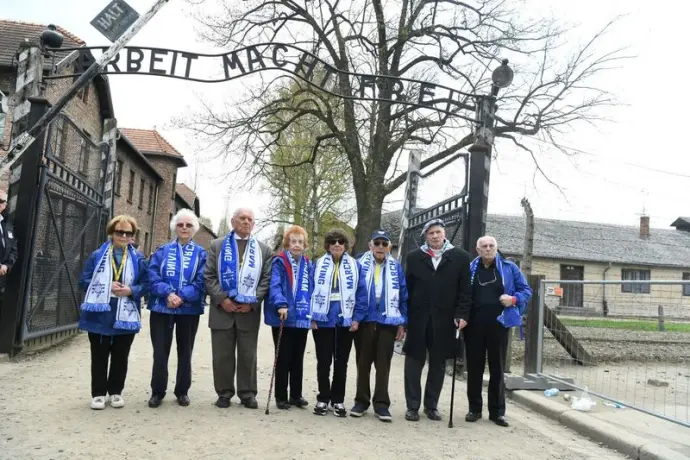
UK March of the Living Holocaust survivors who led the 2022 March of the Living (credit: Yossi Zeliger)
Heideman adds that when the March of the Living was created, few people realized that the level of Holocaust denial and distortion would reach the level that it has today. She notes that during World War II, Dwight D. Eisenhower, Supreme Commander of the Allied Expeditionary Force in Europe, had ordered the US Army to document the atrocities that they had seen in the Ohrdruf concentration camp, because one day, the deniers would surface. “In our perception of what the future would be, no one – even ten years ago – thought we would have to fight such distortion and denial,” says Heideman. “While we educate these young people, it is our hope that through those who have participated in our pre-journey education and their experiences on the ground, we are creating an army of believers in the truth and veracity of the past. It becomes their responsibility to pass on these lessons to the next generation.”
The responsibility of transmitting the lessons of history is difficult work. “Do we sometimes wonder if it is an effort in futility?” says Heideman rhetorically. “I’m sure we do, but what we are undertaking is so monumental – to bring children of other people to this place for one week in Poland and then one week in our homeland. This is our commitment to remember and learn about and from our past. The thing that keeps us going is our drive to pass the torch of memory to the future – to the next generations, so they too understand the evils and potential result of unchecked intolerance and hatred.”
One way that Heideman and Rosenman are trying to transmit the story of the Holocaust and fight those who deny its occurrence is by preserving the physical remnants of what some of the victims left behind – in this case, their shoes.
Perhaps one of the most direct reminders of the Holocaust that visitors to Auschwitz encounter, notes Rosenman, are the thousands of children’s shoes that sit behind a glass case. “There are many Holocaust deniers around the world,” he says. “There is no stronger evidence than this pile of shoes of the children, who were thrown into the crematoriums just an hour after they last wore them. More than one million Jewish children were murdered during the Holocaust. It is our mission to remember.”
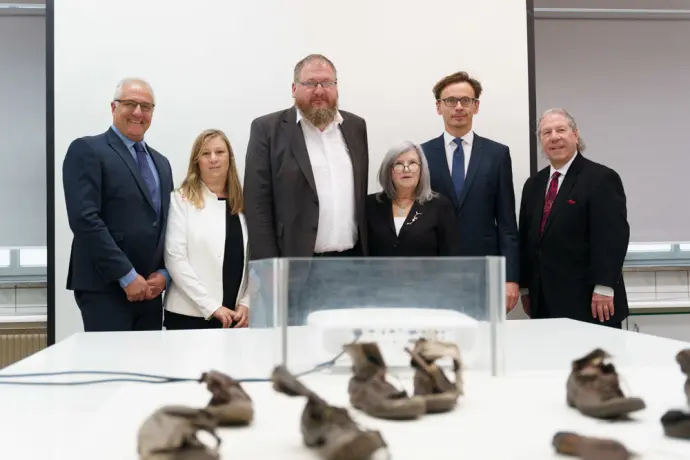
Soul to Sole launch event at Auschwitz preservation lab, September 2022 (credit: MARCH OF THE LIVING)
Soul to Sole launch event at Auschwitz preservation lab, September 2022. From left to right: Greg Masel MOTL senior consultant, Revital Yakin Krakovsky Deputy CEO at the International March of the Living, Dr. Piotr M. A. Cywiński, Director of Auschwitz Memorial, President of Auschwitz-Birkenau Foundation, Wojciech Soczewica, Director General of Auschwitz-Birkenau Foundation & Richard Heideman.
It is for this reason that the International March of the Living and the Auschwitz-Birkenau Foundation have joined in a campaign to preserve 8,000 children’s shoes at Auschwitz that are beginning to decompose. The project, a joint initiative of the March of the Living, the Auschwitz-Birkenau Foundation and the Auschwitz-Birkenau State Museum, is entitled “The Soul to Sole Campaign.”
Heideman recalls her visit to Auschwitz, where she examined the shoes. “We have engaged in salvaging these shoes,” she says, “so that they will not be lost as evidence of the terrible tragedies in Auschwitz and too many other places. Speaking with great emotion, she adds, “Standing there, wearing white gloves and holding in my hand the shoes of a child is a moment in time that I will never forget. These shoes speak. They are the last witnesses. They were ripped off the feet of these children. By restoring them, we are giving dignity and memory to their lives. They will no longer disappear. We will save the last shred of tangible evidence that these poor children – separated from their families and brutally murdered. These shoes have a voice and give us a voice.”This year’s March of the Living, which will be held on April 18th, will be led by 42 Holocaust survivors from countries around the world. Among those joining them will be the United States Ambassador to Israel Thomas Nides; former US Ambassador to Israel David Friedman; Jewish-American businessman Robert Kraft; philanthropist, Miriam Adelson; Mark Wilf, Chair of the Board of Governors of the Jewish Agency for Israel; Doron Almog, Chair of the Jewish Agency for Israel; Ifat Ovadia Luski, Chair of KKL-JNF; Iris and Haim Taib, third-generation of Holocaust survivors of Auschwitz and Tunisia; Philanthropists Eitan Neishlos and Mati Kochavi who recently made major contributions to restoring the shoes of the children murdered in Auschwitz – Birkenau as part of March of the Living “Soul to Sole” campaign, Pastor Lawrence Allen Huch; Israeli Minister of Education Yoav Kisch; Miller Center’s Police commissioners delegation from Europe and the United States; and thousands of students and adults representing a diverse cross-section of the world’s population.
Close to 10,000 people are expected to participate in this year’s March, and Rosenman notes that over the past ten years, the number of non-Jewish participants has been increasing. This year, almost 3,500 people who are not Jewish will be attending from Austria, Germany, Lithuania, Poland and other European countries. “We believe that these people are the best means of telling the stories of the survivors to their communities even as their schools are doing little in this regard.”
Heideman points out that the March of the Living is a full-time organization that organizes activities on many levels in addition to the March itself. “When this organization started, we were perceived to be a once-a-year program,” she says. “We now operate twelve months of the year through our region’s local offices around the globe as well as on an international level. We are proud to have webinars, seminars, classes, educational programs and holding commemorative marches throughout Europe.”
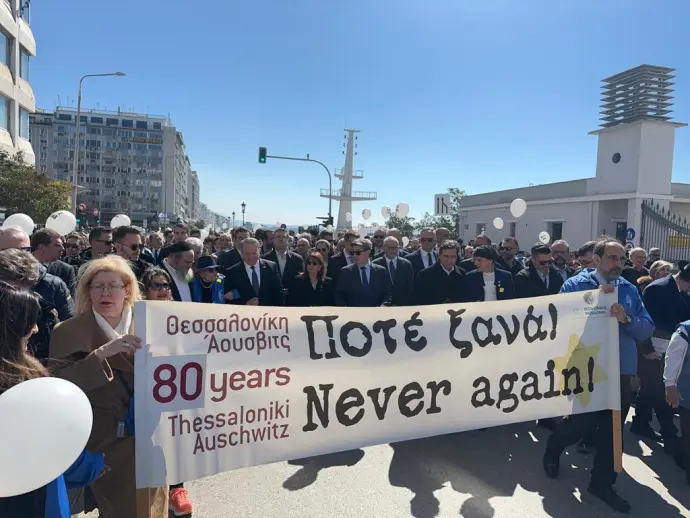
March of the Living in Thessaloniki, March 2023 (credit: EMOTL)
In mid-March, the organization conducted a march through the Greek city of Thessaloniki, marking eighty years since the deportation of Greek Jews during the Holocaust. The event, organized by the European March of the Living, together with local city and state government officials, was led by Greek President Katerina Sakellaropoulou, senior Greek and Israeli officials, and Holocaust survivors and their families. It followed the path that the Germans forced the city’s Jewish population to take in 1943, from a central square opposite the port to the old train station, from where they were deported in cattle cars to Auschwitz-Birkenau.
“Kristallnacht” commemoration event in Dubai, November 2022. From left to right: Emirati students, H.E Ahmed Obaid Al-Mansoori Founder of the Crossroads of Civilization Museum, Eitan Neishlos MOTL Ambassador to the Gulf States, Eve Kugler Holocaust survivor, Phyllis Greenberg Heideman President of the International March of the Living and Revital Yakin Krakovsky Deputy CEO at the International March of the Living (credit: MOTL)
In November 2022, the March of the Living marked the 84th anniversary of Kristallnacht, the “night of broken glass,” when hundreds of synagogues were burned across Germany, and thousands of Jewish-owned businesses were damaged or destroyed by Nazi vandals, with commemorations in Vienna and Dubai. Says Heideman ironically, “We have so much antisemitism, yet we have a waiting list of people who want to come with us on the March of the Living in recognition of the importance of memory.”
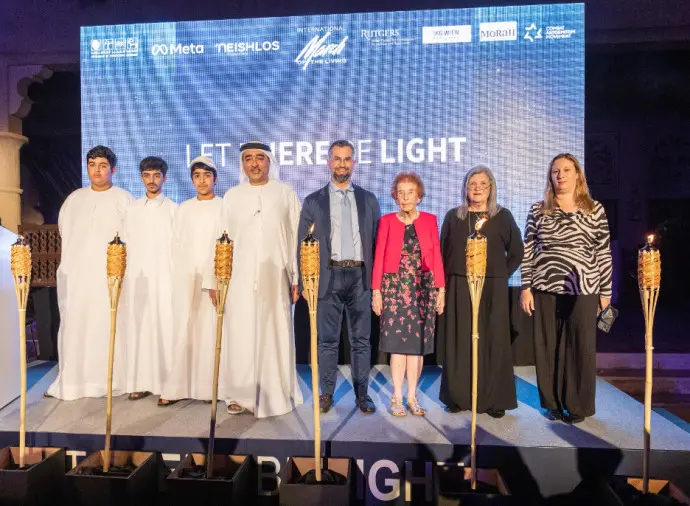
“Kristallnacht” commemoration event in Dubai, November 2022 (Credit: MOTL)
Rosenman has attended every March held since its inception, and Heideman has not missed a March since 2008. They have numerous recollections of the events, what Heideman calls “March Moments,” of listening to survivors, meeting with marchers, and the March’s effect on those who have attended. Rosenman recalls the largest March of the Living in 2005, in which close to 18,000 people participated. The late Ariel Sharon, Israel’s prime minister at the time, and the late Elie Wiesel, the noted writer, activist and Holocaust survivor, were in attendance, along with many survivors. “So many survivors came by train from Warsaw,” says Rosenman. “The train station sign where they arrived said ‘Auschwitz,’ and for many, it was the closing of a circle.”
In that same March, a reporter from one of the major television networks in the United States approached Rosenman and criticized him for being unable to “let go” of what had occurred. Says Rosenman, “He said to me, ‘I understand, but it is already so many years since the war. It’s enough.’ At that point, we all understood quite well that our mission had not yet been accomplished.”
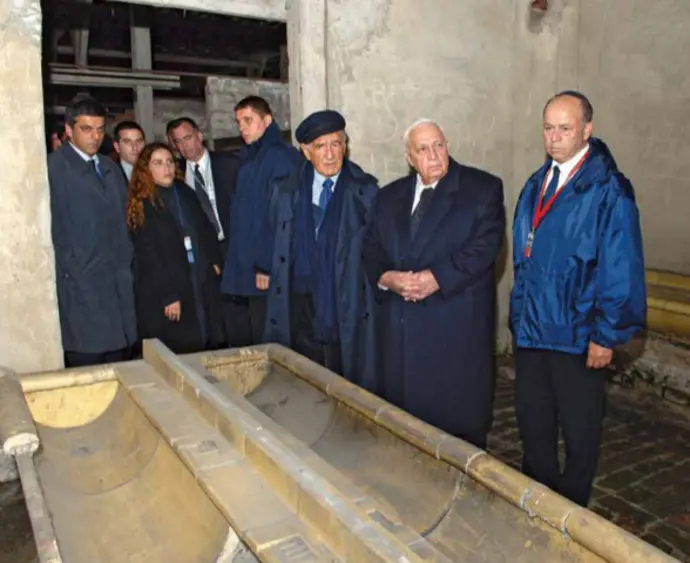
Prime Minister Ariel Sharon, Holocaust survivor Elie Wiesel, Chair of the International March of the Living Dr. Shmuel Rosenman (Credit: MOSHE MILNER)
Heideman explains the impact of the March of the Living by relating a story from the March that took place ten years ago. “In 2013, we brought a delegation of blind adults from Jerusalem with their guide dogs to the March of the Living. When the March had concluded, we were sitting on the ground in front of the stage. I came to speak to the blind people to thank them for their participation. One blind woman said to me, ‘I want you to know that while I saw nothing, I felt everything.” Heideman pauses for a moment before continuing. “That is the impact of marching with thousands of people from 52 countries around the globe. She felt everything. They saw nothing. They couldn’t see what you and I see. They didn’t see the shoes. They didn’t see the hair, the prison, the hospital or the crematoria, but they understood the meaning of this place. I’ll never forget it as long as I live. We can only imagine that if it impacts someone who couldn’t see the soil, the camps and the buildings – imagine the impact we can make for those who can embrace all the six senses. That is why we do what we do.”
Those who embrace the March of the Living with all of their senses, she continues, will be impacted by the March throughout their lives. “It touches lives and changes the trajectory of those who will let it,” says Heideman. “Many participants who have this experience will move on with their lives, but a greater number will make commitments to themselves – if not at the moment of the March, later in life, either on the college campus in their married life or in the beginning days of parenthood. They understand the importance of what they witnessed with their eyes.”
Paraphrasing Elie Wiesel, Heideman adds, “He taught us that when you listen to a witness, you become one. Many of our participants embrace the notion of the importance of memory and the need to stand up and accept social responsibility to do what you can, to ensure that something like this never happens to another people again.”
As our interview comes to a close, Heideman says, “This is a higher calling. It is holy work. We are doing the word of God in their memory, and they deserve it – not just the victims, but the survivors. We welcome anyone into our ranks, not just financially but emotionally and physically. Our doors and our arms are open.”
Rosenman, for his part, quotes a passage from Ethics of the Fathers (2:16), which reads, “It is not your duty to finish the work, but neither are you at liberty to neglect it.” “We are not the beginners of the work, says Rosenman, “but we are the carriers, and we believe that many other people can join us to fight what the world already forgot.”
